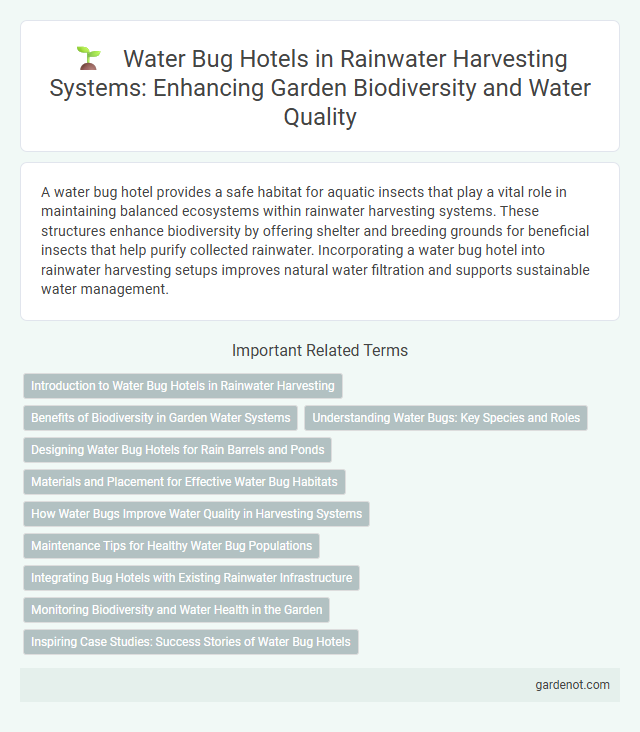A water bug hotel provides a safe habitat for aquatic insects that play a vital role in maintaining balanced ecosystems within rainwater harvesting systems. These structures enhance biodiversity by offering shelter and breeding grounds for beneficial insects that help purify collected rainwater. Incorporating a water bug hotel into rainwater harvesting setups improves natural water filtration and supports sustainable water management.
Introduction to Water Bug Hotels in Rainwater Harvesting
Water bug hotels serve as essential habitats for aquatic invertebrates, promoting biodiversity within rainwater harvesting systems. These structures enhance natural water filtration by supporting species that break down organic matter and control mosquito larvae populations. Incorporating water bug hotels into rainwater collection areas improves ecosystem health and sustains water quality.
Benefits of Biodiversity in Garden Water Systems
Water bug hotels enhance garden water systems by creating habitats for diverse aquatic insects that naturally control pests and improve water quality. These structures promote a balanced ecosystem, supporting beneficial species that contribute to nutrient cycling and reduce algae growth. Incorporating biodiversity through water bug hotels increases resilience and sustainability in rainwater harvesting setups.
Understanding Water Bugs: Key Species and Roles
Water bug hotels provide critical habitats for aquatic insects such as backswimmers, water boatmen, and pond skaters, which play essential roles in maintaining healthy freshwater ecosystems. These species contribute to natural pest control by feeding on mosquito larvae and aid in nutrient cycling within rainwater harvesting systems. Recognizing the behavior and ecological functions of these water bugs enhances the efficiency and biodiversity of rainwater collection habitats.
Designing Water Bug Hotels for Rain Barrels and Ponds
Designing water bug hotels for rain barrels and ponds involves creating habitats that attract beneficial aquatic insects, enhancing ecosystem health and water quality. Key features include using natural materials like twigs, leaves, and hollow stems to provide shelter and breeding grounds, while ensuring stable moisture levels and protection from predators. Integrating these structures near rainwater collection systems supports biodiversity and promotes the natural regulation of insect populations.
Materials and Placement for Effective Water Bug Habitats
Construct water bug hotels using natural materials like bamboo, hollow reeds, wood chips, and stone to mimic their preferred wet and sheltered environment. Place these structures near slow-moving or stagnant water sources such as ponds, rainwater collection tanks, or garden reservoirs to ensure consistent moisture and shelter. Position the hotels partially submerged or at water margins, shaded by vegetation, to enhance humidity and protect insects from extreme temperatures.
How Water Bugs Improve Water Quality in Harvesting Systems
Water bugs play a crucial role in enhancing water quality within rainwater harvesting systems by feeding on algae, detritus, and organic waste, which helps reduce nutrient buildup and prevents algal blooms. Their biological activity promotes the natural breakdown of pollutants and supports beneficial microbial communities that further purify the water. Incorporating water bug habitats, such as bug hotels, fosters a balanced ecosystem that maintains cleaner and healthier harvested rainwater.
Maintenance Tips for Healthy Water Bug Populations
Regularly clean and inspect the water bug hotel to prevent algae buildup and remove debris that can block water flow. Ensure the water level remains consistent to provide a stable habitat for water bugs and avoid stagnant conditions that encourage mosquito breeding. Replace any damaged materials promptly to maintain structural integrity and support a thriving water bug population essential for natural pest control.
Integrating Bug Hotels with Existing Rainwater Infrastructure
Integrating bug hotels with existing rainwater infrastructure enhances urban biodiversity by providing habitats for beneficial insects within rainwater harvesting systems. These structures support natural pest control and pollination, improving ecosystem services linked to rain gardens and retention basins. Combining rainwater storage with bug hotel elements optimizes space and promotes sustainable water management and wildlife conservation.
Monitoring Biodiversity and Water Health in the Garden
Water bug hotels provide a critical habitat for aquatic invertebrates that serve as bioindicators for monitoring biodiversity and water quality in rainwater harvesting systems. Regular observation of species diversity and population dynamics within the bug hotel helps assess the ecological health of garden water sources. Data collected enables early detection of pollutants and supports sustainable management practices to maintain clean, balanced aquatic environments.
Inspiring Case Studies: Success Stories of Water Bug Hotels
Water bug hotels have transformed urban water management by providing essential habitats for aquatic insects vital to ecosystems. One inspiring case study from Melbourne demonstrates how community-led water bug hotel installations improved local water quality and increased biodiversity in stormwater ponds. These success stories highlight scalable models integrating water bug hotels into sustainable rainwater harvesting practices.
Water bug hotel Infographic

 gardenot.com
gardenot.com